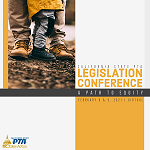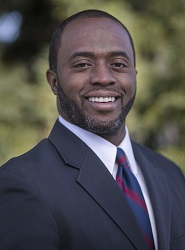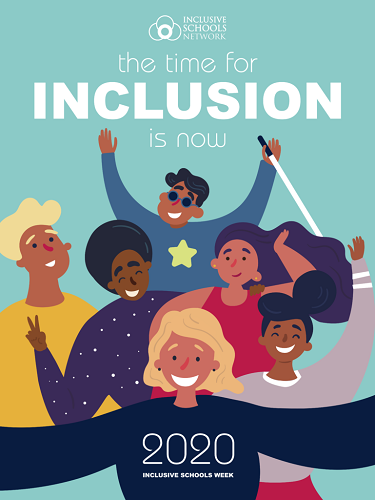By Derby Pattengill, Vice President, Health and Community Concerns
During the week of December 6, schools across the country will be raising awareness about how to make sure every classroom offers opportunities for ALL children to succeed. The national Inclusive Schools Week celebration offers ideas that local PTAs can use throughout the year to create fun inclusion programs, examine your own practices, and encourage school leaders to do the same.
Inclusive Schools Week is an annual event sponsored by the Inclusive Schools Network (ISN) and Stetson & Associates, Inc., which is held each year during the first full week in December. As the sponsors explain, “For 20 years, Inclusive Schools Week has celebrated the progress that schools have made in providing a supportive and quality education to an increasingly diverse student population, including students who are marginalized due to disability, gender, socio-economic status, cultural heritage, language preference, and other factors. The week also provides an important opportunity for educators, students, and parents to discuss additional steps schools can take to continue to improve their ability to successfully educate all children.”
This year, the Inclusive Schools Week’s theme is “Rebuilding our Inclusive Community Together.” Join us in celebrating Inclusive Schools Week December 6-12, 2021!
In inclusive schools, the shared ownership for student success extends throughout the entire school community – from bus drivers to crossing guards, from administrators to custodians, from cafeteria workers to front office personnel, and everyone in between. Together they work to foster relationships within the school and create awareness of effective inclusive practices. For example, research has consistently demonstrated that inclusive teaching practices that present information in ways that are relevant and meaningful to each and every student can improve academic achievement for all students.
In celebration of the week, your PTA unit, council or district could send out a press release, announce your celebration in local media outlets, and post updates on your school website, etc. Even better, consider ways to promote inclusive schools all year long by:
- Convening a planning team of faculty, students and family members.
- Creating excitement by hosting poster and essay contests, hanging a banner in your school lobby or appropriate virtual location.
- Utilizing ready-made resources and materials to support your celebration and continuous efforts to promote and develop practices in your community.
You’ll find a wealth of resources and ideas on the Inclusive Schools Network website, including this year’s Featured Activities. School administrators play a crucial role in creating and supporting inclusive schools. Additional information and activities for them are available on the National Association of Secondary School Principals (NASSP) website here.
We encourage you to share your successes with the California State PTA. Click here to share your success stories!
 California State PTA believes that all children deserve a quality education regardless of the community in which they live, the color of their skin, their language, their gender identity, or their immigration status.
California State PTA believes that all children deserve a quality education regardless of the community in which they live, the color of their skin, their language, their gender identity, or their immigration status. We all want all families to feel welcome at our schools.
We all want all families to feel welcome at our schools. “A Path to Equity” was the focus of this year’s Legislation Conference, which I attended as a local PTA leader and advocate, but also as the parent of two public high school students. Bringing equity to California public schools has long challenged our educational leaders, and the pandemic has highlighted vast inequities in the system and left millions of California students more disadvantaged than ever. From access to mental health care and meals to the widening of a vast digital divide, the conference underscored that the prospect of getting students back on track is daunting. Far from being pessimistic, however, the conference presented information and opportunities that we as parents and PTA advocates can use to disrupt ineffective old practices and bring public education into a new era in which all are included and empowered, and in which the needs of all are seen and addressed.
“A Path to Equity” was the focus of this year’s Legislation Conference, which I attended as a local PTA leader and advocate, but also as the parent of two public high school students. Bringing equity to California public schools has long challenged our educational leaders, and the pandemic has highlighted vast inequities in the system and left millions of California students more disadvantaged than ever. From access to mental health care and meals to the widening of a vast digital divide, the conference underscored that the prospect of getting students back on track is daunting. Far from being pessimistic, however, the conference presented information and opportunities that we as parents and PTA advocates can use to disrupt ineffective old practices and bring public education into a new era in which all are included and empowered, and in which the needs of all are seen and addressed. State Superintendent Tony Thurmond opened the conference and focused on restorative justice and increased digital access and literacy as examples of measures needed at the state level to increase inclusiveness and access for all students. President Celia Jaffe shared CAPTA’s ten recommendations for the timely and safe reopening of schools. Director of Legislation Shereen Walter shared CAPTA’s legislative agenda and the critical need for “our collective voices to influence legislation and the state budget to improve equity, access, and opportunity for all of California’s children.” Then, National PTA President-Elect Anna King shared her personal stories of witnessing how racial and economic inequities affected her own children, injustices which led directly to her involvement in PTA and her work to bring a collective voice on behalf of all children to our nation’s leaders and educational decision-makers. This was a powerful start to the conference.
State Superintendent Tony Thurmond opened the conference and focused on restorative justice and increased digital access and literacy as examples of measures needed at the state level to increase inclusiveness and access for all students. President Celia Jaffe shared CAPTA’s ten recommendations for the timely and safe reopening of schools. Director of Legislation Shereen Walter shared CAPTA’s legislative agenda and the critical need for “our collective voices to influence legislation and the state budget to improve equity, access, and opportunity for all of California’s children.” Then, National PTA President-Elect Anna King shared her personal stories of witnessing how racial and economic inequities affected her own children, injustices which led directly to her involvement in PTA and her work to bring a collective voice on behalf of all children to our nation’s leaders and educational decision-makers. This was a powerful start to the conference. Twitter:
Twitter: